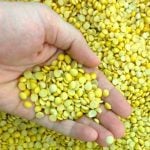Jeff Rowe, CEO of the Syngenta Group, doesn’t often get home to his farm near Princeton, Illinois. He’s usually operating from his base in Basel, Switzerland, instead. But when he does get back to the Midwest, you might catch up to him running a planter in the spring or the combine in the fall, just as he was on a recent October day when I made my own trip to meet him.
The John Deere S780 combine was harvesting corn, and Rowe watched the display range from 240 to 300 bushels at about 15 per cent moisture while we discussed leadership, goals and the future of agriculture products.
The magnitude of his job can seem staggering. The Syngenta Group has four divisions: Syngenta Crop Protection, Syngenta Seeds, Adama and Syngenta China, and it has employees working in more than 100 countries.
Syngenta’s 2023 income is reported at $32.2 billion. As I say, “staggering.”
Read Also

What to consider when setting up farm-related business ventures
Things to consider before launching a farm-adjacent side business.
Still, Rowe does find time to get home a couple of times per year and gives a hand to his father, Dean, who runs the 3,000-acre farm with family help and a full-time employee.
Syngenta is owned by ChemChina, but is managed mostly by North Americans based in Switzerland, and Rowe wants to tell me it is the leading supplier of crop protection products in the world.
But Country Guide had a specific question we wanted to ask, so I steer our conversation a bit. I ask, What makes an Illinois farmboy the right fit to lead one of agriculture’s largest companies?
I want to know, is there anything that farmers can find in his career that could help them grow and manage their own businesses?
Rowe tackles the question sideways. He starts by saying that being rooted in agriculture is a good foundation, but it’s essential too to know how to manage the vision of the company, especially in such a large organization.
Rowe started in the CEO position in early 2024 after leading Syngenta’s crop protection and seed divisions.
He also says something few farmers would expect. “When you get a company the size of Syngenta and with the success of Syngenta,” he says, “there are multiple people who could do the job.”
Rowe, though, is in the top job not just because of a lifetime dedicated to agriculture or because of his experience running two of the company’s divisions. It’s also because of how he has managed his own career. Specifically, over his 30 years working in agriculture, he’s had roles in legal, research, supply chain, manufacturing and even in livestock.
“One of the things that I think has been very helpful for me in my career and particularly early in my career is that I was never focused, frankly, on the money or the title,” he says. “I was focused on learning, and I also did a lot of different things.”
That breadth of experience prepared him for his current role, he says. But even so, he keeps an open mind. He’s got wide experience, but that doesn’t mean he knows everything, even if he is now in charge of the entire group of companies.
“I came into it (the CEO position) with the expectation that I would learn a lot— and I have learned a lot,” he says.
“The common thread? It’s really about people in a lot of ways. It’s about making sure you’ve got the right people at the right jobs, and you’re supporting people and you’re developing people.”
That helps him drive the two-phased strategic focus, which is the management priority of the Syngenta Group.
The first phase, in an industry hit by falling commodity prices, is to get financially healthier. The second is to introduce innovative new products, including biocontrols and biostimulants.
Biocontrols will be the most challenging in the marketplace, he says, but new products Plinazolin, a seed treatment, Tymirium, a soil nematode and fungal control (both in the approval process in Canada), and Adepidyn, a fungicide that is part of the Miravis brand, will each generate $1 billion a year in sales, he predicts.
Understanding customers and employees requires a key ability, he says. You have be able to put yourself in their shoes, and you have to listen well.
Then, beside me in the combine, he takes control from the autosteer and stops to let me off. There’s more work to do.
But before I leave, he tells me, “As a leader you need to go where the people are. When I go to talk to employees, or customers, I don’t speak to them and expect them to adjust to me. I try to understand what’s important to them. I think that’s important for leaders.”















